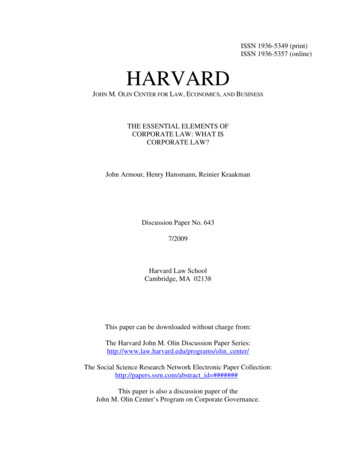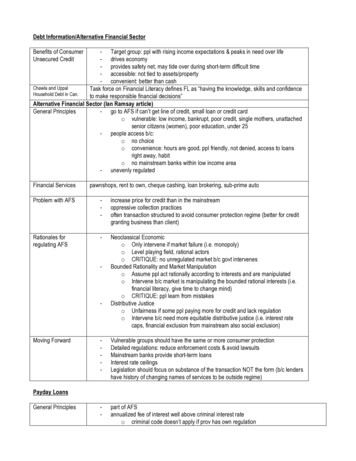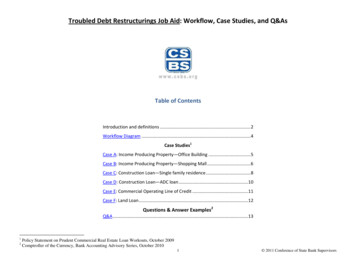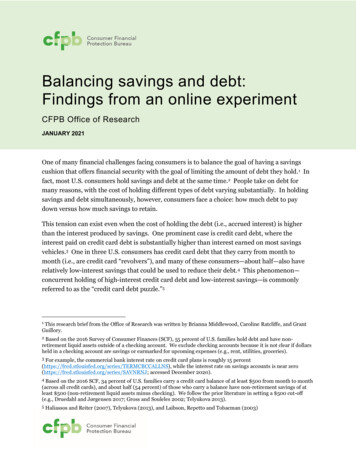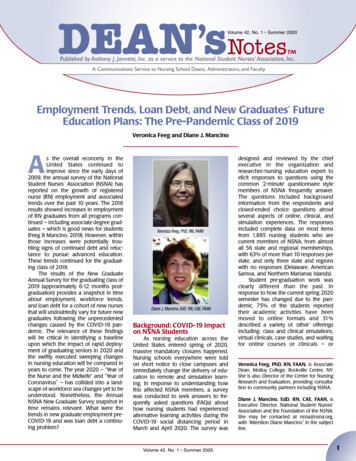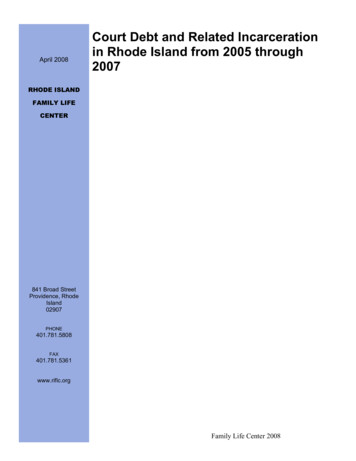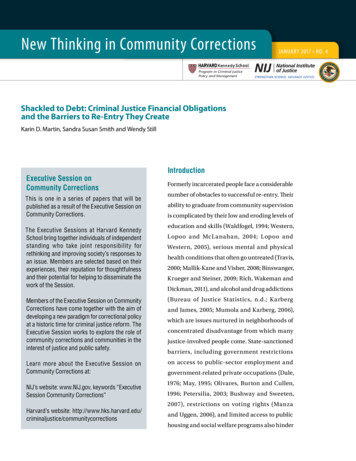
Transcription
New Thinking in Community CorrectionsVERITASJANUARY 2017 NO. 4HARVARD Kennedy SchoolProgram in Criminal JusticePolicy and ManagementShackled to Debt: Criminal Justice Financial Obligationsand the Barriers to Re-Entry They CreateKarin D. Martin, Sandra Susan Smith and Wendy StillIntroductionExecutive Session onCommunity CorrectionsFormerly incarcerated people face a considerableThis is one in a series of papers that will bepublished as a result of the Executive Session onCommunity Corrections.ability to graduate from community supervisionThe Executive Sessions at Harvard KennedySchool bring together individuals of independentstanding who take joint responsibility forrethinking and improving society’s responses toan issue. Members are selected based on theirexperiences, their reputation for thoughtfulnessand their potential for helping to disseminate thework of the Session.Members of the Executive Session on CommunityCorrections have come together with the aim ofdeveloping a new paradigm for correctional policyat a historic time for criminal justice reform. TheExecutive Session works to explore the role ofcommunity corrections and communities in theinterest of justice and public safety.Learn more about the Executive Session onCommunity Corrections at:NIJ’s website: www.NIJ.gov, keywords “ExecutiveSession Community Corrections”Harvard’s website: tycorrectionsnumber of obstacles to successful re-entry. Theiris complicated by their low and eroding levels ofeducation and skills (Waldfogel, 1994; Western,Lopoo and McLanahan, 2004; Lopoo andWestern, 2005), serious mental and physicalhealth conditions that often go untreated (Travis,2000; Mallik-Kane and Visher, 2008; Binswanger,Krueger and Steiner, 2009; Rich, Wakeman andDickman, 2011), and alcohol and drug addictions(Bureau of Justice Statistics, n.d.; Karbergand James, 2005; Mumola and Karberg, 2006),which are issues nurtured in neighborhoods ofconcentrated disadvantage from which manyjustice-involved people come. State-sanctionedbarriers, including government restrictionson access to public-sector employment andgovernment-related private occupations (Dale,1976; May, 1995; Olivares, Burton and Cullen,1996; Petersilia, 2003; Bushway and Sweeten,2007), restrictions on voting rights (Manzaand Uggen, 2006), and limited access to publichousing and social welfare programs also hinder
2 New Thinking in Community Correctionsreintegration efforts (Carey, 2004; Thompson,of fairness in the administration of justice in2004). Despite recent successes1 in an effort toa democratic society and engendering deep“ban the box” — the “box” on employment anddistrust of the criminal justice system amongcollege applications that asks about criminalthose overburdened by them.history — the social stigma that justice-involvedpeople face further compounds problems withIn what follows, we describe trends in there-entry, including their attempts to find workassessment of CJFOs, discuss the historical(Pager, 2003, 2007).context within which these trends have unfolded,and reflect on their unintended (but perhapsTo this lengthy list we add yet another significanteasily foreseen) consequences. We then treatstate-sanctioned barrier — criminal justicerestitution separately, given the distinct functionfinancial obligations (CJFOs), also known as(in theory at least) that restitution serves. We alsomonetary sanctions or legal financial obligations.raise serious concerns about how restitutionThere are at least five types of CJFOs (Rubacktends to be implemented and who benefits fromand Bergstrom, 2006; Harris, Evans and Beckett,this particular obligation. We end by considering2010): fines and forfeiture of property, which arealternative models for the effective and fairintended as punishment; costs and fees, includingdeployment of fines, fees and restitution in thebut not limited to court costs and supervisioncriminal justice context.fees, which reimburse the state for costsassociated with the administration of justice;Historical and Institutional Contextand restitution, a financial payout to specificCJFOs are not new. According to Harris andvictims or a general fund designated for them,colleagues (2010: 1758), “monetary sanctionsintended to compensate victims for the losseswere integral to systems of criminal justice,they have suffered. Although some have writtendebt bondage, and racial domination in theabout the benefits of incorporating CJFOs as oneAmerican South for decades.” Although theiroption among many criminal justice sanctionsuse waned significantly in the first half of the(Morris and Tonry, 1990; Gordon and Glaser,20th century, CJFOs have proliferated since1991; Ruback and Bergstrom, 2006), this form ofthe 1980s. As a result of statutes and policies atsanction can, if left unchecked, have long-termevery level — city/municipal, county, state andeffects that significantly harm the efforts offederal — that mandate various forms of CJFOs,formerly incarcerated people to rehabilitate andthe vast majority of people who come into contactreintegrate, thus compromising key principleswith the criminal justice system and are found2guilty (and some who are not) pay for theseCite this paper as: Martin, Karin D., Sandra Susan Smith, and Wendy Still.Shackled to Debt: Criminal Justice Financial Obligations and the Barriersto Re-Entry They Create. New Thinking in Community Corrections Bulletin.Washington, D.C.: U.S. Department of Justice, National Institute of Justice,2017. NCJ 249976.encounters or are punished for not doing so.
Shackled to Debt: Criminal Justice Financial Obligations and the Barriers to Re-entry They Create 3The 1960s and 1970s marked an opening forWith this shift in values came the implementationthe resurgence of CJFOs. According to Garlandof a set of rigid criminal justice policies —(2001), the rehabilitative approach to crime anddeterminate sentencing, truth in sentencing,punishment had been hegemonic since the 1890s.mandatory minimums and three strikes — thatUnder this approach, crime was understood innot only drove up rates of incarceration but alsoterms of relative deprivation. Specifically, whendramatically increased the numbers of thosedeprived of proper education, socialization,under supervision outside the nation’s jails andopportunities and treatment, individuals wereprisons (Western, 2006; Wacquant, 2009; Raphaelmore likely to become involved with the justiceand Stoll, 2013). Between 1925 and 1975, fewersystem. But with individualized treatment, aidthan 100 Americans per 100,000 were in prison.to and supervision of families, institutionalizedBy 2003, even though crime rates had remainedsupports for education, and job creation andrelatively stable, this number had quadrupledtraining, people would likely abstain from furtherto more than 400 per 100,000. Further, betweencriminal behavior. Mass protests of the 1960s1983 and 2001, incarceration (jail and prison) inand 1970s, however, inspired a marked shift inthe United States increased from 275 inmatesvalues and approaches to criminal justice. Withper 100,000 to 686 inmates per 100,000, moreunrest related to the Vietnam War, women’sthan five times the rate in Western Europeanliberation and various Civil Rights revolutionscountries (Western, 2006). The numbers of peoplethreatening to fundamentally disrupt theunder community supervision also increasedfoundation on which well-established racial,dramatically. In 1980, Wacquant (2009) reportsgendered and class-based hierarchies had beenthat 1.84 million were on probation or parole. Bybuilt, many people raised serious concerns about1990, that figure had increased to 4.35 million andthe rehabilitative approach, arguing that it wasjumped again to 6.47 million by 2000 (Wacquant,ineffective (relative to alternative approaches) at2009).addressing the emerging threats society faced.These critics favored the retributive approachThe proliferation of CJFOs was likely a result, directinstead. In this approach, criminal behaviorand indirect, of this cultural shift to retribution.was not considered a deviation from the normFirst, in an era of “just deserts” punishment, thebut rather a rational choice by self-serving actorsincreased use of fines and forfeiture, alone or inwho were taking advantage of opportunitiescombination with other forms of nonmonetaryin contexts where sufficient controls andsanctions, signaled to the public that people whodisincentives for crime were weak or nonexistent.committed crimes were being made to accountState efforts at retribution, incapacitation and thefor their actions (Wacquant, 2009). Second, themanagement of risk would effectively curtail such1970s cultural shift included increased concernself-serving, opportunistic behaviors.3for victims who, it was argued, should be
4 New Thinking in Community Correctionsmade whole — through reparations — afterthe type of offense, may now be assessed (Nieto,experiencing crime-related losses (Office for2006). Texas has 15 categories of court costsVictims of Crime, 2013; Garland, 2001).that are “always assessed” and an additional 18discretionary CJFOs that include fees for beingThird — and perhaps most important — ascommitted or released from jail (Texas Districtthe criminal justice apparatus swelled toCourt, 2013). In Washington state, a defendantaccommodate the oceans of people cycling inwith a single conviction is subjected to 24 finesand out of the system’s courts, jails, prisons, andand fees (Beckett and Harris, 2011).probation and parole departments, so too havethe costs to operate such a system. For instance,Jurisdictions have also shifted costs to justice-Wacquant (2009) shows that, between 1980 andinvolved people by increasing the amounts1997, criminal justice budgets — those devotedand numbers of fines, fees and surcharges theyto police, justice and corrections — increasedassess. For instance, since 1996, Florida addedfrom roughly 35 billion to 130 billion permore than 20 new categories of CJFOs andyear. Growth in criminal justice personnel alsorecently increased amounts of existing fees andskyrocketed, from approximately 1.3 millionsurcharges in two consecutive years (Bannon,in 1980 to 2.1 million in 1997. Wacquant (2009)Nagrecha and Diller, 2010; Diller, 2010). In Newnotes that, based on the number of personnelYork state — where the laws require 10 mandatoryin 1997, American criminal justice was the thirdsurcharges, 19 fees5 and six civil penalties ranginglargest employer in the country, second only tofrom 5 to 750 — lawmakers have repeatedlyManpower, Inc., and Walmart.increased the amounts and numbers of fees andsurcharges since the early 1990s (Rosenthal andHowever, legislators have been reluctant to passWeissman, 2007). In 2008 alone, two “additionalthese dramatically rising costs on to taxpayers.surcharges” were assessed for driving offenses;Jurisdictions have instead shifted more of thefees for assistance to victims of misdemeanorcosts to justice-involved people through CJFOscrimes and felony crimes were increased by 5(Wacquant, 2009), implicating every stage ofeach; and surcharges for felonies, misdemeanorscriminal case processing (Bannon, Nagrechaand violations were increased by 5 to 50and Diller, 2010).4 They have done so in at least(Bannon, Nagrecha and Diller, 2010). In 2009,three ways — by imposing numerous new fines,North Carolina initiated two new fees — a 25fees and surcharges; by increasing the amountslate fee for debtors making tardy payments andassociated with CJFOs; and by adopting morea 20 surcharge for those wishing to establish aproactive strategies to collect debt. In California,payment plan for their CJFOs. North Carolina alsofor instance, 16 different statutes codify 269increased fees for defendants who fail to appearseparate court fines, fees, forfeitures, surchargesin court and increased the costs associated withand penalty assessments that, depending onlab tests (Bannon, Nagrecha and Diller, 2010).
Shackled to Debt: Criminal Justice Financial Obligations and the Barriers to Re-entry They Create 5Since 2010, 48 states have increased civil andFor persons who a re i nca rcerated, t hecriminal fees (Shapiro, 2014), a likely responseoverwhelming majority now accumulate moundsto government coffers emptied by the effects ofof debt due to numerous fees while behind bars.the Great Recession (Burch, 2011; GovernmentA 1997 survey of the nation’s largest jails revealedAccountability Office, 2015). It is no wonder, then,that more than three-quarters of people in jailthat CJFOs have become ubiquitous.6were charged fees for a host of programs andservices, most notably medical care, per diemWith ubiquity, the odds of justice-involvedpayments, work release programs and telephonepersons receiv ing one or more monetar yuse; the latter three produced the greatest revenuesanctions and the median amounts assessedby far. By 2005, that figure had risen to 90 percent.have increased substantially.7 For instance,In addition, more than 85 percent of people onHarris and colleag ues (2010) report t hatprobation and parole are now required to pay25 percent of federal prison inmates weresupervision fees, fines, court costs or restitutionassessed fines, but that figure rose to 66 percentto victims to remain free from further sanctionsby 2004 — only 13 years later. 8 Although the(Travis and Petersilia, 2001; Rainville and Reaves,prevalence of fines and restitution payments2003; Siegel and Senna, 2007).subsided to 32 percent of federal nonimmigrationcases in 2015, it is important to note that theThe result of this expansion in the numbers andoverwhelming majority of cases for some federalamounts of CJFOs, deployed at every stage ofoffenses — robbery, fraud, larceny, arson andcriminal case processing, is that some 10 millionburglary, for instance — received a fine or werepeople owe more than 50 billion from contactrequired to pay restitution (U.S. Sentencingwith th
every level — city/municipal, county, state and federal — that mandate various forms of CJFOs, the vast majority of people who come into contact with the criminal justice system and are found guilty (and some who are not) pay for these encounters or are punished for not doing so. Shackled to Debt: Criminal Justice Financial Obligations and the Barriers to Re-entry They Create 3 The 1960s .


